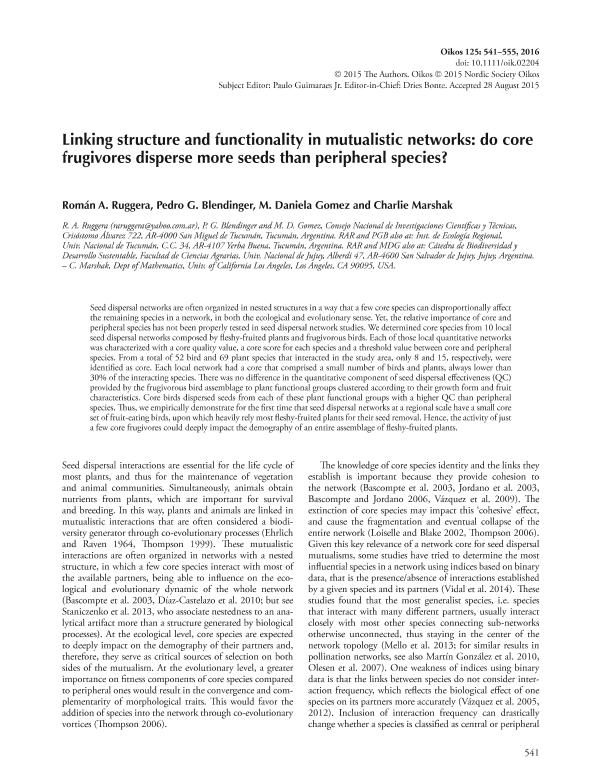Artículo
Linking structure and functionality in mutualistic networks: Do core frugivores disperse more seeds than peripheral species?
Fecha de publicación:
04/2016
Editorial:
Wiley Blackwell Publishing, Inc
Revista:
Oikos
ISSN:
0030-1299
Idioma:
Inglés
Tipo de recurso:
Artículo publicado
Clasificación temática:
Resumen
Seed dispersal networks are often organized in nested structures in a way that a few core species can disproportionally affect the remaining species in a network, in both the ecological and evolutionary sense. Yet, the relative importance of core and peripheral species has not been properly tested in seed dispersal network studies. We determined core species from 10 local seed dispersal networks composed by fleshy-fruited plants and frugivorous birds. Each of those local quantitative networks was characterized with a core quality value, a core score for each species and a threshold value between core and peripheral species. From a total of 52 bird and 69 plant species that interacted in the study area, only 8 and 15, respectively, were identified as core. Each local network had a core that comprised a small number of birds and plants, always lower than 30% of the interacting species. There was no difference in the quantitative component of seed dispersal effectiveness (QC) provided by the frugivorous bird assemblage to plant functional groups clustered according to their growth form and fruit characteristics. Core birds dispersed seeds from each of these plant functional groups with a higher QC than peripheral species. Thus, we empirically demonstrate for the first time that seed dispersal networks at a regional scale have a small core set of fruit-eating birds, upon which heavily rely most fleshy-fruited plants for their seed removal. Hence, the activity of just a few core frugivores could deeply impact the demography of an entire assemblage of fleshy-fruited plants.
Archivos asociados
Licencia
Identificadores
Colecciones
Articulos(SEDE CENTRAL)
Articulos de SEDE CENTRAL
Articulos de SEDE CENTRAL
Citación
Ruggera, Román Alberto; Blendinger, Pedro Gerardo; Gomez, Maria Daniela; Marshak, Charlie; Linking structure and functionality in mutualistic networks: Do core frugivores disperse more seeds than peripheral species?; Wiley Blackwell Publishing, Inc; Oikos; 125; 4; 4-2016; 541-555
Compartir
Altmétricas




